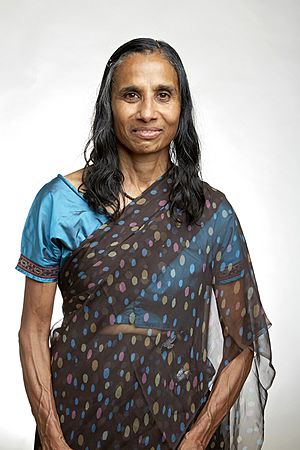Lalita Ramakrishnan facts for kids
Quick facts for kids
Lalita Ramakrishnan
FRS FMedSci
|
|
|---|---|

Ramakrishnan in 2018
|
|
| Born | 1959 (age 66–67) |
| Alma mater | Baroda Medical College Tufts University |
| Spouse(s) | Mark Troll |
| Parent(s) |
|
| Relatives | Venki Ramakrishnan (brother) |
| Awards | Member of the National Academy of Sciences (2015) EMBO Member (2019) |
| Scientific career | |
| Fields | Microbiology Immunology Infectious diseases |
| Institutions | University of Cambridge University of Washington |
| Thesis | Abelson virus-transformed cells as models of early B lymphocyte differentiation (1990) |
Lalita Ramakrishnan (born 1959) is an Indian-born American microbiologist who has made amazing discoveries about the disease tuberculosis (TB). A microbiologist is a scientist who studies tiny living things like bacteria.
As of 2019, she is a professor at the University of Cambridge in England. She is also a doctor and a top researcher for the Wellcome Trust, a major health research foundation. Her lab is at the famous MRC Laboratory of Molecular Biology. There, she leads a team studying how our bodies fight off diseases.
She is famous for using tiny, see-through zebrafish to study how TB works. This clever idea has helped scientists understand the disease in a whole new way. Her important research has been published in top science journals like Science and Nature.
Contents
Early Life and Education
Ramakrishnan was born in 1959 in Baroda (now called Vadodara), India. Science ran in her family. Both of her parents were scientists, and her brother, Venki Ramakrishnan, later won a Nobel Prize. When Lalita was a child, her own mother suffered from a type of tuberculosis, which sparked her interest in the disease.
In high school, Ramakrishnan was very good at math and physics. She started medical school at just 17 years old. In 1983, she earned her medical degree from Baroda Medical College.
After taking a class on immunology (the study of the body's defense system), she decided to make it her specialty. She moved to the United States and earned a PhD in Immunology from Tufts University in 1990. She then trained as a doctor specializing in infectious diseases. Later, she worked in the lab of a famous scientist named Stanley Falkow at Stanford University. It was there that she first developed the idea of using zebrafish to study TB.
Groundbreaking Research on Tuberculosis
In 2001, Ramakrishnan became a professor at the University of Washington. She worked both as a scientist and a doctor, helping patients with infectious diseases.
A New Way to Study TB: The Zebrafish
At the University of Washington, Ramakrishnan began using zebrafish to study tuberculosis. This was a brilliant idea because zebrafish are a great model for understanding TB in humans.
Zebrafish babies, called larvae, are transparent. This means scientists can look right through their bodies with a microscope. Ramakrishnan infected the see-through larvae with Mycobacterium marinum, a bacterium that is a close relative of the one that causes TB in people.
Because she could see everything happening inside the living fish, she could watch the infection step-by-step. This allowed her to see exactly how the bacteria and the fish's immune system fought each other. This method helped her understand how a granuloma forms. A granuloma is a tiny ball of immune cells that the body builds to wall off germs.
Discovering How TB Bacteria Work
Ramakrishnan's work in Seattle and later at Cambridge led to major discoveries. She and her team found out how TB bacteria trick the body.
They discovered that the bacteria have a fatty coating that helps them get inside the right kind of immune cells, called macrophages. Instead of being destroyed, the bacteria use these cells as a safe place to live and multiply.
She also found that the bacteria can trick the body into building granulomas that actually help the bacteria instead of the host. Inside these granulomas, the bacteria are protected. When the infected cells inside the granuloma die, it helps the bacteria grow even faster and spread. These discoveries have led to new ideas for treatments that could help patients fight TB.
Rethinking "Latent" Tuberculosis
For a long time, many scientists believed in an idea called "latent tuberculosis." This was the theory that TB bacteria could hide in a person's body for many years without making them sick, only to "wake up" and cause disease later. It was thought that a quarter of all people in the world had this latent TB.
However, Ramakrishnan and her colleagues looked closely at the evidence. In 2018 and 2019, they published papers in the British Medical Journal arguing that this idea was mostly wrong. They showed that most people who get infected with TB either get sick within a few months or their body clears the infection completely.
They argued that fewer than 10% of people who are infected for more than two years will ever get sick, even if their immune system gets weak. This is a huge deal because it changes how we should spend money on TB research. Ramakrishnan said that a lot of money was being spent "chasing after latency" based on a misunderstanding. Her work suggests that research should focus on helping people in parts of the world where TB is a major, active problem.
Awards and Honors
Ramakrishnan's important work has earned her many awards.
- In 2015, she was elected a Member of the U.S. National Academy of Sciences, a huge honor for a scientist.
- In 2018, she was elected a Fellow of the Royal Society (FRS) in the United Kingdom.
- She was also made a member of the European Molecular Biology Organization (EMBO) in 2019.
These awards show how much other scientists respect her and her incredible contributions to understanding and fighting disease.

